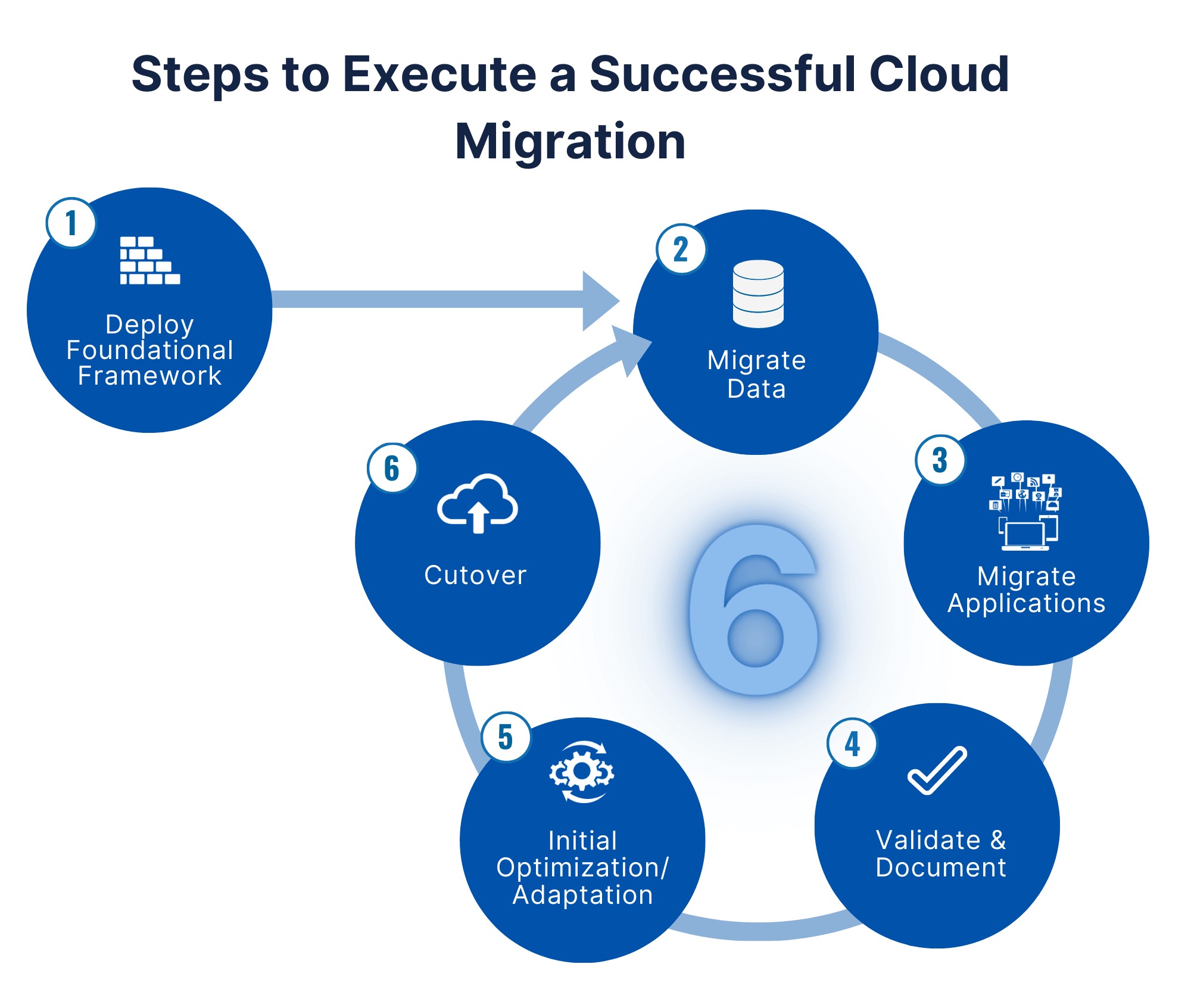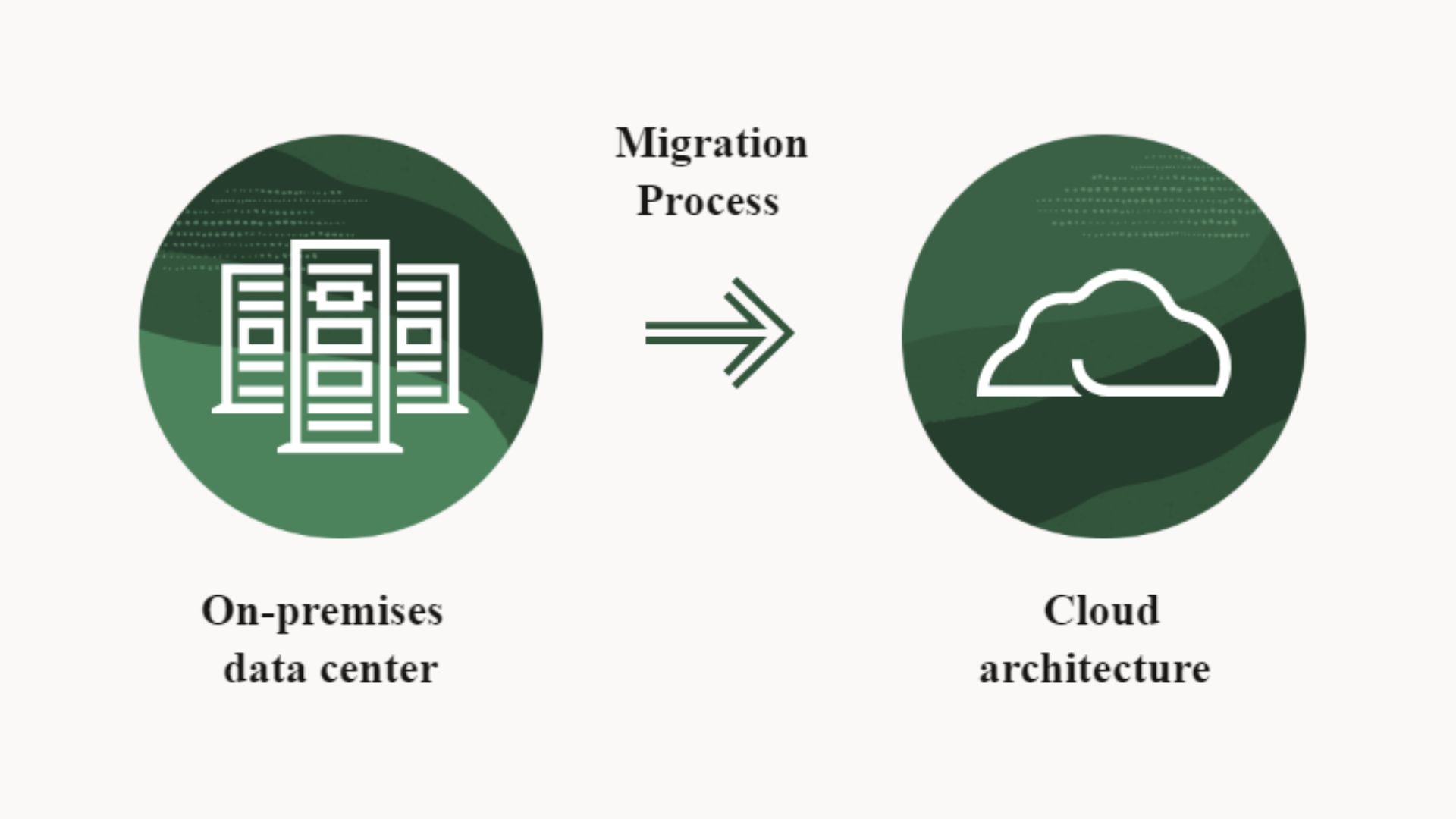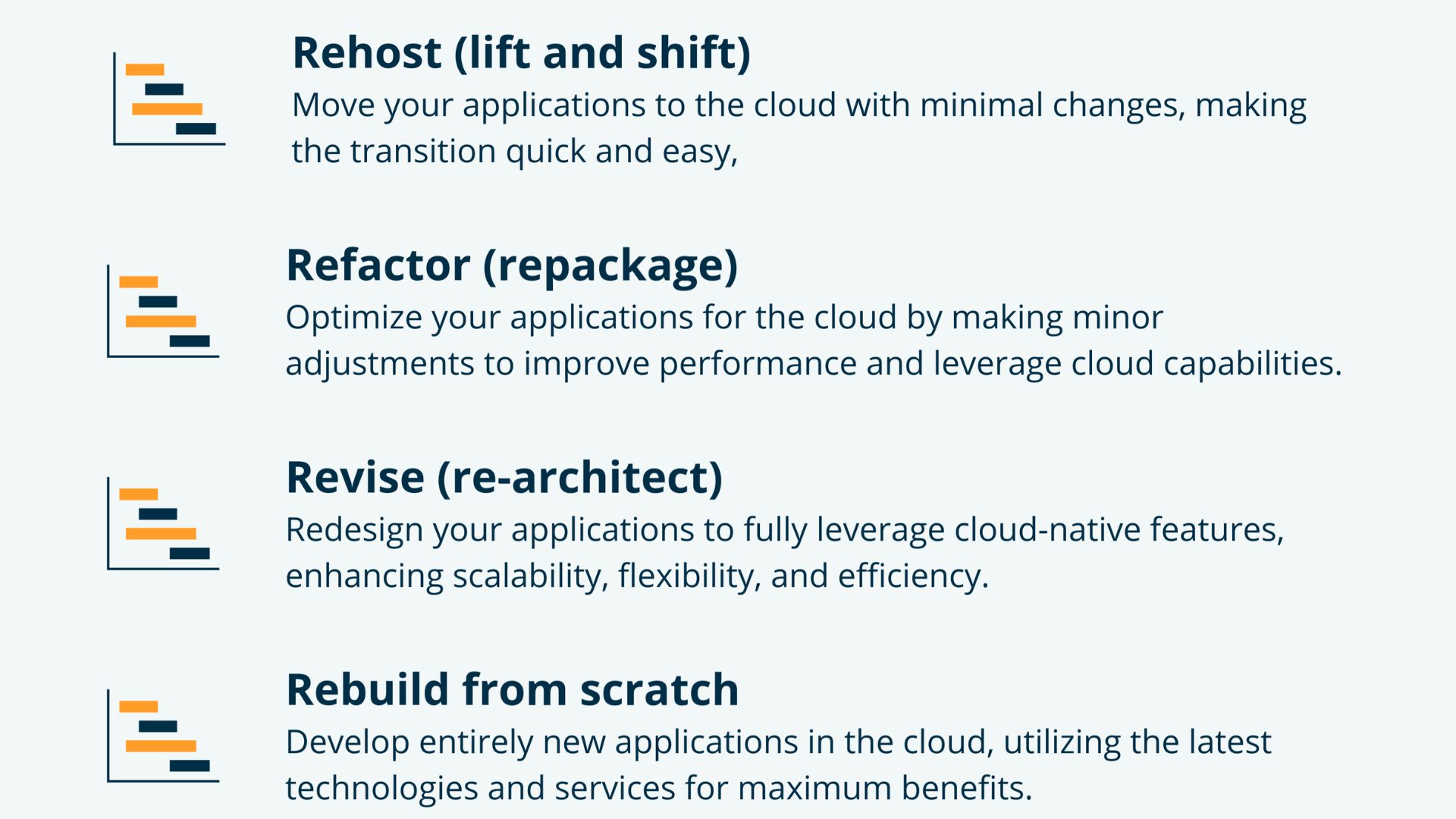
In today's rapidly evolving digital landscape, the shift to cloud computing has become a pivotal strategy for businesses seeking agility, scalability, and efficiency. But when businesses set out on this revolutionary path, managing cloud migration and guaranteeing compliance become crucial obstacles.
Fundamentally, moving to the cloud is a strategic decision that requires careful consideration of how it will affect data security, company operations, and regulatory compliance. It is not only a technology advancement. Businesses face a new set of compliance responsibilities when they shift their data and apps to the cloud.
Furthermore, cloud migration governance goes beyond compliance. It includes an all-encompassing method of managing cloud resources, guaranteeing that the migration is in line with the organization's larger goals and yields the expected advantages.
Careful planning, well-defined policies, risk assessment, and ongoing oversight are all necessary components of effective governance that guarantee the cloud environment is safe, effective, and compatible with changing legal requirements.
This article aims to delve into the intricacies of cloud migration, focusing on the pivotal aspects andtips for governing cloud migration & compliance, which are often overshadowed by the technical facets of the migration process.
What Is Cloud Migration?
The process of moving an organization's infrastructure, data, and apps to a cloud service provider is known as cloud migration. For companies that make the switch, this shift can result in cost savings, flexibility, scalability, and automated maintenance.
The choice to migrate should be made after giving serious thought to each organization's unique business requirements. When it comes to cloud migration, governance and compliance are crucial factors to take into account.
To keep the trust of partners, consumers, and other stakeholders, organizations must make sure that any new platforms adhere to their established standards and any applicable laws or regulations.
They also need to have rules in place for data protection and access control in the new platform environment. They must also think about the most efficient way to audit system actions on a regular basis in order to track changes over time properly.
Depending on their needs, organizations can select from public, private, or hybrid clouds; however, each of these models has a different level of security risk, necessitating the use of suitable governance measures like encryption methods, authentication procedures, and auditing procedures.
Moreover, some industries like healthcare and finance have requirements that must be met, and before a migration can be completed successfully, extra levels of regulatory compliance may be necessary. Planning with these things in mind can help firms stay compliant as they transition from antiquated systems to cutting-edge cloud-based solutions.
Challenges Of Cloud Migration
In spite of the fact that moving to the public cloud comes with a plethora of clear advantages, there are a number of significant obstacles that you need to take into consideration before making the transition. The following are some of the more significant challenges;
Minimizing Disruption
Given that businesses frequently report that a single hour of downtime may cost more than one hundred thousand dollars, it is essential to ensure that any migration to the public cloud is carried out in such a way that the interruption of applications is kept to a minimum.
Your operations will suffer, and the expenses will soon increase if users or customers are unable to access apps or data properly.
Safety And Regulatory Compliance
There is a genuine need for companies to guarantee not just that the data they move to the cloud is safe but also that they remain compliant with relevant rules while migrating to the cloud. This is because fresh stories that highlight massive data breaches are constantly appearing every day.
Wasted Cloud Budget
It is important to note that in some studies, cloud users have provided estimations that up to thirty percent of their organization's cloud expenditure has been wasted.
This is significant because one of the primary advantages of the public cloud is the cost reduction that the service model offers in comparison to the provisioning of on-premise equipment. It should come as no surprise that the public cloud is only as cost-effective as each individual makes it.
Skills Gap
Expertise is scarce when it comes to professionals who are competent in safeguarding cloud systems and ensuring that cloud migrations run as smoothly as possible.
More than personnel who are familiar with information technology security is required since public cloud security necessitates familiarity with the key platforms and the subtleties of those platforms, such as Amazon Web Services and its identity and access management.
Tips For A Successful Cloud Migration
Business Motivation For Cloud Migration
Understanding your company's motive is the first step towards a successful cloud migration. Businesses should pose the following queries to themselves;
- Why do we wish to switch to cloud computing?
- What is our company's value proposition?
- What objectives do we want to fulfill with the migration?
Cost reductions are among the most often mentioned justifications for moving to the cloud. Pay-as-you-go pricing methods for cloud services are flexible, lowering the cost of IT infrastructure, upkeep, and support.
Additionally, businesses may boost productivity by using the cloud to access secure, scalable, and highly accessible platforms. Instead of concentrating on infrastructure upkeep, developers may concentrate on creating applications.
Reducing time-to-market is another driver driving cloud migration for businesses. The cloud makes it possible to swiftly and efficiently launch and scale new services and applications. Businesses can get a competitive edge by doing this, enabling them to launch their goods and services more quickly.
Moving to the cloud gives businesses more flexibility and scalability, which allows them to tailor resources to their natural requirements better. They can readily modify their IT infrastructure in response to internal or market developments and react to them more swiftly.
Before beginning a cloud migration project, businesses must understand their business goals. Then, and only then, can they be sure that they accomplish their objectives and make the most of the cloud's advantages.
Building Expertise
A thorough grasp of cloud computing technology, cloud architecture, cloud security, cloud management tools, compliance, and data protection regulations is necessary for a successful cloud migration.
Expertise in networking, virtualization, storage, security, and application architecture is essential for the IT teams handling the move. They should also be able to thoroughly assess and balance the advantages and disadvantages of various cloud models, including IaaS, PaaS, and SaaS.
It is crucial to remember that only some businesses have the tools and knowledge required to complete a cloud migration successfully. In these situations, hiring a seasoned cloud service provider to help with the transfer is advised.
Cloud service providers may assist businesses with the planning, carrying out, and managing of a successful migration since they often have a great deal of expertise and deep understanding in the field of cloud computing.
At this point, decision-makers must have a fundamental grasp of cloud computing technologies and how they affect the business in order to make well-informed choices.
This is true for more than just the IT departments inside the corporation. Workshops and training can be beneficial in gaining the requisite information and making sure that all parties involved are in agreement. Adequate preparation and cooperation with knowledgeable cloud specialists are essential for a company's cloud migration to be successful.
Get Executive Sponsorship And Stakeholder Buy-In
A successful cloud migration depends on getting executive backing and making sure essential stakeholders are involved in the decision-making process. Start by listing the important decision-makers and influencers in your company, including C-level executives, IT directors, and business unit managers.
Inform these stakeholders of the advantages and strategic importance of moving to the cloud, emphasizing the benefits that are unique to their positions and responsibilities.
Gaining their support will enable more efficient decision-making and create a cooperative atmosphere that will aid in the cloud migration process. Projects involving cloud migration can only sometimes go as expected, and the connections made throughout this endeavor might come in particularly handy when negotiating difficult circumstances.
Properly Manage Software Licensing
In the cloud, managing software licensing correctly is essential. Whether or not an enterprise's current on-premise software licenses translate to the cloud is a serious challenge.
Enterprises are granted explicit authorization to move their applications to the cloud through the Bring Your Software and License (BYOSL) program offered by some software suppliers. Usage rights are specified by other suppliers based on the quantity of concurrent users.
Documenting every company application and carefully examining its licensing policies in light of cloud computing is a wise course of action.
If you have any questions, get in touch with the vendor to find out whether you can change the licenses you currently have so that the program may be utilized in the cloud. The dangers, expenses, and complications of moving license management to the cloud may be minimized with the help of Software Asset Management (SAM) solutions.
Automate Where Possible
It is not acceptable for any cloud migration plan to have downtime or service interruptions. Automating repetitive routines wherever feasible is a crucial best practice to reduce disruption and boost overall migration efficiency.
Automation reduces risk and expense while also accelerating the transfer process. Even programs exist that promise to assist you in automating the data and virtual machine transfer process.
Moreover, scripts come in handy in situations like migrating databases from an on-premises to a cloud version. The progressive cloud migration strategy and automation can complement one another as you gradually find recurring patterns that can be automated in later migration stages.
Leverage Service Provider Support
The degree of assistance you'll receive should have been taken into consideration while making your pick if you've done your homework on cloud service providers. Adequate support staff may be a vital ally in any project involving cloud migration.
Experts in the specific service they provide, cloud support employees need to be able to quickly address any technical queries or assist you with any problems you may be having.
Cloud Migration - Budget And Costs
Making the switch to the cloud may require significant financial outlays. Therefore, it's a good idea to plan and create a reasonable budget in order to keep expenses in check.
This entails taking into account both operational and capital expenses (Opex and Capex). A thorough upfront cost estimate is necessary to guarantee practical planning and a successful cloud migration deployment.
The consideration of Total Cost of Ownership (TCO) is also necessary. The total cost of ownership (TCO) describes how much it costs to run and maintain infrastructure and applications for their lives.
Over time, Software as a Service (SaaS) delivers considerable benefits in terms of availability, scalability, and maintenance while initially seeming more expensive than self-hosting solutions. Regular cost evaluations optimize return on investment and assist in controlling expenditures.
Scalability and adaptability are other factors to take into account in budget planning. Businesses should make sure that their cloud infrastructure is still scalable so they can react fast to demands that change in the market or with their operations.
Moving to the cloud has economic benefits in addition to benefits for the IT infrastructure's scalability and flexibility. Cloud migration removes any investment risk, whereas traditional on-premises IT infrastructure frequently necessitates large capital expenditures (Capex) for hardware and equipment.
Instead, businesses usually pay an annual or monthly price (Opex) for cloud services that are flexible enough to meet their demands. Companies have more financial freedom to invest in other aspects of their organization as IT spending becomes more predictable.
The Importance Of Compliance In Cloud Migration
A significant change in how businesses handle their data and IT resources is brought about by the movement of commercial activities to the cloud. Although there are many advantages to this shift, like increased scalability, cost savings, and efficiency, there are also many new and complicated compliance obligations.
It is impossible to overestimate the significance of compliance in cloud migration as it is essential to safeguarding the company, its information, and its clients.
Privacy And Data Security
The necessity to safeguard sensitive data is at the core of compliance with cloud migration. Businesses must make sure that data transferred from on-premises systems to cloud environments stays private and secure.
This is especially important for sectors like healthcare, banking, and legal services that handle sensitive data. Following regulations such as GDPR, HIPAA, or PCI DSS is a commitment to protect client and customer data against breaches and illegal access, in addition to being required by law.
Regulatory Adherence
Organizations are required to comply with specific regulations that are relevant to their industry and location. For example, the United States' HIPAA sets requirements for patient health information protection, while the European Union's GDPR imposes stringent regulations on data processing and privacy.
Serious repercussions for noncompliance might include significant fines and legal actions. In order to make sure that the cloud services and processes comply with the relevant legal frameworks, cloud migration strategies must consider these rules.
Building Trust
Additionally, compliance is a trust issue. Clients and customers are becoming more conscious of data security and privacy problems.
Organizations may improve their reputation and gain the trust of their stakeholders by demonstrating their commitment to data protection through compliance with pertinent rules. In the digital era, when privacy issues and data breaches may seriously harm a brand's reputation, this trust is vital.
Risk Control
Identifying and reducing the risks connected to cloud migration is made easier with effective compliance. It includes evaluating the possible dangers of unauthorized access, data loss, and security flaws.
Organizations may create robust risk management procedures that guard against these risks and get them ready for unanticipated difficulties by adhering to compliance requirements.
Business Continuity
The maintenance of long-term operational continuity depends on compliance, which guarantees that cloud-based activities are carried out within a moral and legal framework.
Disruptions resulting from non-compliance may include legal challenges or the requirement to rework systems and procedures in order to comply with compliance requirements. Organizations may secure a more seamless operating flow and prevent these delays by incorporating compliance from the beginning of cloud migration.
Future-Proofing The Business
The legal environment is constantly changing, so being compliant while migrating to the cloud is a constant effort rather than a one-time chore. Organizations may more readily adjust to upcoming regulatory changes by adopting a compliance-centric strategy for cloud migration.
By using this proactive approach, the company may stay compliant over time and prevent having to make expensive, time-consuming revisions down the road.
Beyond just following the law, compliance is a crucial component of cloud migration. It includes safeguarding the security and privacy of data, abiding by legal obligations, cultivating stakeholder confidence, successfully managing risks, maintaining operational continuity, and future-proofing the company.
Because of this, it needs to be the main factor taken into account in any cloud migration plan, directing choices and activities to guarantee a smooth and long-lasting move to the cloud.
Frequently Asked Question
How Can You Maintain Data Security During Cloud Migration?
Implement robust encryption methods for data in transit and at rest, conduct regular security audits, and ensure your cloud provider adheres to high-security standards.
What Role Does A Cloud Governance Framework Play?
A Cloud Governance Framework establishes guidelines for managing cloud resources, ensuring consistent policy enforcement, risk management, and compliance adherence throughout the migration process.
How Do You Handle Compliance In A Multi-Cloud Environment?
In a multi-cloud environment, it's crucial to understand the compliance capabilities and responsibilities of each cloud provider and ensure your governance framework addresses the complexities of operating across multiple clouds.
Conclusion
Controlling cloud migration and guaranteeing compliance is a complex task that calls for meticulous preparation, calculated execution, and constant attention to detail. Organizations moving to cloud-based solutions face a challenging environment in terms of operational risks, privacy laws, and data security.
Understanding and upholding compliance standards, tips for governing cloud migration & compliance, putting strong governance structures in place, and encouraging a culture of security and compliance awareness among all stakeholders are essential for successful cloud migration.
Businesses may reduce risks and fully utilize cloud computing to stimulate development and innovation by giving priority to these components. Long-term performance in the cloud and compliance with the ever-changing regulatory landscape depends on being knowledgeable and flexible.




